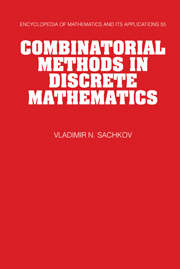Preface
Published online by Cambridge University Press: 22 March 2010
Summary
This book is addressed to those who are interested in combinatorial methods of discrete mathematics and their applications. A major part of the book can be used as a textbook on combinatorial analysis for students specializing in mathematics. The remaining part is suitable for use in special lectures and seminars for the advanced study of combinatorics. Those parts which are not intended for teaching include Sections 2.3, 3.6, 3.7, 5.3, 5.6, 5.8, 6.3, 6.4 and Subsection 5.1.3 where the material contains either special questions concerning applications of combinatorial methods or rather cumbersome derivations of asymptotic formulae. Of course, a course of studies in discrete mathematics can be biased towards asymptotic methods, where the selection of material can be different and where the above-mentioned sections become basic.
Some knowledge of algebra and set theory, summarized in Section 1.1, is assumed. To understand the derivations of asymptotic formulae, the reader must be familiar with those results of complex analysis usually included in standard courses for students specializing in mathematics.
For the convenience of those readers who are interested in the separate questions contained in the book, I have attempted to make the presentation of each chapter self-contained and, for the most part, independent of the other chapters.
As is usual, I acknowledge those authors whose results are presented in the book and provide the corresponding citation. The list of references is given at the end of the book.
The method of citation is unified. Citations of theorems, lemmas, corollaries, formulae, etc., include the chapter number, section number and own number within the section. For example, Theorem 1.2.3 is theorem number 3 in Section 2 of Chapter 1.
- Type
- Chapter
- Information
- Combinatorial Methods in Discrete Mathematics , pp. vii - viiiPublisher: Cambridge University PressPrint publication year: 1996

